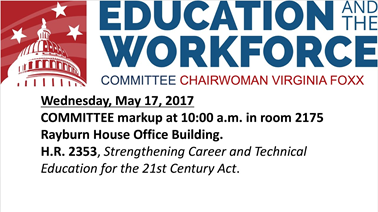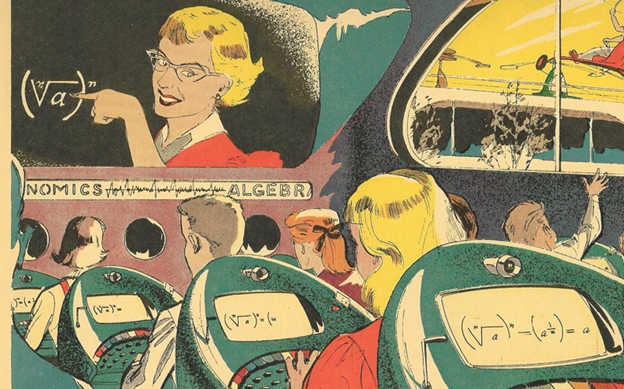President Trump signs bipartisan technical-education bill into law – By Laura Meckler, The Washington Post
President Trump signed legislation Tuesday that renews a federal workforce development program, sending $1.2 billion a year to states but with fewer requirements from Washington on how to spend the money and assess the success of programs.
The legislation drew bipartisan support.
The legislation renews the Carl D. Perkins Career and Technical Education Act, the primary federal funding source for career and technical-education programs offered in high schools and after graduation. Typically, the programs combine academic instruction with occupational skills training.
Backers estimate the program will help 11 million people develop knowledge and skills needed to find well-paying jobs. That includes students in high school programs and those run by community colleges and technical schools.
The renewed program bars the education secretary from setting local or state standards, and it reduces the secretary’s role in approving state plans for spending the money. Under the previous version of the initiative, states had to negotiate with Washington over their goals for the program, specifically what percentage of students they aimed to graduate from high school. Now these levels will be determined by the states within certain parameters.

How to prepare students for the unknowable – By Adam Garry, eSchool News
The workforce is on the cusp of a major evolution. But will Gen Z—those born after 1996 and just beginning to think about their careers—be prepared with the essential skills to succeed? Now more than ever before, educators have the opportunity and the imperative to engage students in learning tasks that ask them to think critically and problem-solve.
According to an Institute for the Future report, “The Next Era of Human-Machine Partnerships,” emerging technologies like augmented and virtual reality (AR/VR), artificial intelligence/machine learning (AI), big data, cloud computing, and the Internet of Things (IoT) are going to completely transform the workplace by 2030. This change is coming so fast that an estimated 85 percent of the jobs that will make up the future workforce have not yet been invented. At the same time, a survey of business leaders shows than eight in 10 (82 percent) expect that humans and machines will work as integrated teams within their organization inside of five years, and 84 percent expect that all of their workers will be digital experts by the year 2030.
Machines will augment and extend our own abilities, providing us with the advanced knowledge we need to make real-time, data-driven decisions, perform tasks more successfully, and get our jobs done more effectively and efficiently. Consider how the internet has reshaped the workplace by providing us access to faster communication and more in-depth knowledge. AR and VR make our connection to those resources more immediate, natural, and comprehensive, while AI helps us glean more insights from data and make informed decisions.

More teachers are turning to crowdfunding sites to pay for books, supplies, and field trips – By Nadra Nittle, Vox.com
When the education crowdfunding site DonorsChoose.org launched in 2000, Americans were still getting acquainted with Amazon and eBay. If cyber shopping was uncommon, supporting a project through online crowdfunding was nearly unheard of. Today, however, crowdfunding sites are more popular than ever, and teachers particularly are flocking to them.
As of August 3, more than 72,000 projects were posted on DonorsChoose.org, where teachers raise money for everything from books to clothing for students. That’s up from 39,391 on the same date in 2016 and 23,599 in 2015.
Educators use the site to request funding for classroom supplies and school projects, and the public can choose which campaigns to support. Once a project is fully funded, Donors Choose ships the materials directly to the teacher’s school.
In January, Donors Choose celebrated a milestone, the funding of 1 million classroom projects. Just two months later, the cryptocurrency company Ripple funded every project on the site, at a cost of $29 million.

How California is transforming bus drivers, clerks and yard supervisors into teachers – By Dianna Lambert, the Sacramento Bee
Carol Elgin spent last Monday preparing a tiny classroom at Foulks Ranch Elementary School in Elk Grove for students.
She’s waited a long time to have her own class. Over the last six years, Elgin, 55, has been a substitute teacher and instructional assistant. Before that she spent 20 years in sales.
But she had always yearned to be a teacher.
Tuesday her dreams came true when the first group of sixth-grade students took their seats at the horseshoe-shaped table in the middle of her classroom.
The California Classified School Employee Teacher Credentialing Program helped to make her dream a reality. Elgin is one of hundreds of classified employees – generally bus drivers, clerks, yard supervisors and instructional assistants – across California who are getting financial and instructional support to help them earn a teaching credential.
The $20 million grant program was approved by state legislators in 2016 to combat California’s teacher shortage. The grants pay $4,000 annually per participant for up to five years to help them complete a bachelor’s degree and earn a teaching credential.
Sacramento State instructors come to Elk Grove Unified campuses to offer evening classes to the cohort. The state grant pays 40 percent and Elk Grove Unified 60 percent of the cost.












